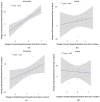Learning to Listen: Changes in Children's Brain Activity Following a Listening Comprehension Intervention
- PMID: 39062408
- PMCID: PMC11273652
- DOI: 10.3390/bs14070585
Learning to Listen: Changes in Children's Brain Activity Following a Listening Comprehension Intervention
Abstract
"Are you LISTENING?" may be one of the most frequent questions preschoolers hear from their parents and teachers, but can children be taught to listen carefully-and thus better comprehend language-and if so, what changes occur in their brains? Twenty-seven four- and five-year-old children were taught a language simulation strategy to use while listening to stories: first, they practiced moving graphics on an iPad to correspond to the story actions, and then they practiced imagining the movements. Compared to a control condition, children in the intervention answered comprehension questions more accurately when imagining moving the graphics and on a measure of transfer using a new story without any instruction and with only immovable graphics. Importantly, for children in the intervention, the change in comprehension from the first to the sixth day was strongly correlated with changes in EEG mu and alpha desynchronization, suggesting changes in motor and visual processing following the intervention. Thus, the data are consistent with our hypothesis that a language simulation listening comprehension intervention can improve children's listening comprehension by teaching children to align visual and motor processing with language comprehension.
Keywords: effortful control; learning; listening comprehension; sensorimotor system; simulation; transfer of training.
Conflict of interest statement
Arthur Glenberg is part-owner of Moved by Reading, LLC, which may commercialize the EMBRACE intervention. The funders had no role in the design of the study; in the collection, analyses, or interpretation of data; in the writing of the manuscript, or in the decision to publish the results.
Figures



References
-
- Hulme C., Snowling M.J. Children’s reading comprehension difficulties: Nature, causes, and treatments. Curr. Dir. Psychol. Sci. 2011;20:139–142. doi: 10.1177/0963721411408673. - DOI
Grants and funding
LinkOut - more resources
Full Text Sources
Research Materials

